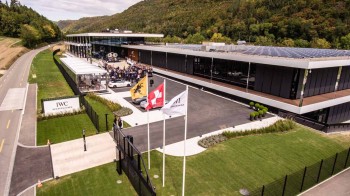When a steel frame weighing over 1,000 tonnes, supporting 14,600 cubic metres of concrete and 2,650 square metres of glass partitions has to bring life to micro-components weighing just a few milligrams, while providing a working environment of the highest quality for the 240 employees who work there each day, that’s quite a challenge. But it seems to have succeeded. It might have been years in the planning (the 20,000 m2 plot of land near Schaffhausen was bought in 2012), but construction of the 13,500 m2 “Manufacturzentrum” took just 21 months. That’s quite an achievement in itself, given that renovating a luxury boutique on the Bahnhofstrasse or the Rue du Rhône can typically take longer. Eighty companies were involved in the construction, but at the heart of the project were Christoph Grainger Herr and his teams, who had input into the design, planning and execution, taking aesthetic decisions and choosing the materials.
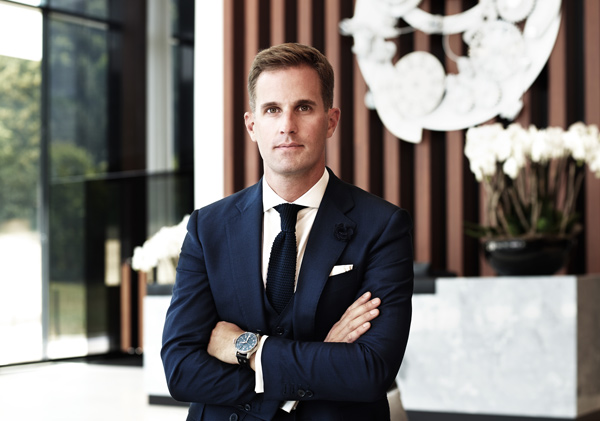
The architect of time
In the words of the CEO, who first joined IWC as architect and designer, “Architecture is about much more than just designing a utilitarian building. A building is a living space – an environment that directly affects the way people live or work. Our employees call it their professional ‘home’. The building's architecture influences their day-to-day activities and their social relationships. An architect therefore needs to understand how people behave and how they interact with one another. This holistic approach has always fascinated me.” That’s obvious from the fact that his aims reach far beyond essential functionality: “We wanted a building with a high aesthetic value which perfectly expressed the spirit of our brand, expresses IWC from a structural point of view to our staff and visitors. That’s why I had an input in the initial designs for the outside of the building, and gave it its basic architectural direction.”
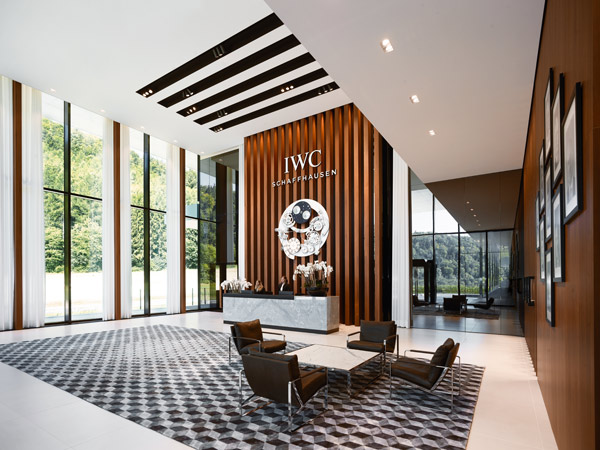
While white and black are the dominant colours (even the machines have all been repainted white), the young boss decided to make the building more welcoming by incorporating touches of wood, “to give the new building the character of a house, with a generous veranda, and to create a warm atmosphere.” If you want colour, you have to look through the big glass windows to the changing hues of the wooded hills behind. Staff can also appreciate the surrounding landscape from the vast panoramic terrace of the cafeteria on the upper level. The intensity of the light that enters through the windows can be modulated depending on the needs of the watchmakers and the impact of the external temperature. So where did the inspiration come from? “I had modernist exhibition pavilions in mind at the time. These pavilions have allowed countries to showcase their greatest achievements in terms of technology, trade and art. This blend of gallery, workshop and engineering trade fair seemed to me to be a fitting architectural foundation on which to base the design, and the classical modernist style is an excellent match for our brand.”

CHF 42 million: the price of the future
CHF 42 million is the amount officially invested in this ultra-modern building, which is the pride of IWC and the authorities of Schaffhausen, whose name appears on the dials of the watches that are dispatched to every corner of the globe. And, given its strategic importance for the future of the brand, and compared with other similar projects undertaken by the watch industry, the price tag seems entirely reasonable.
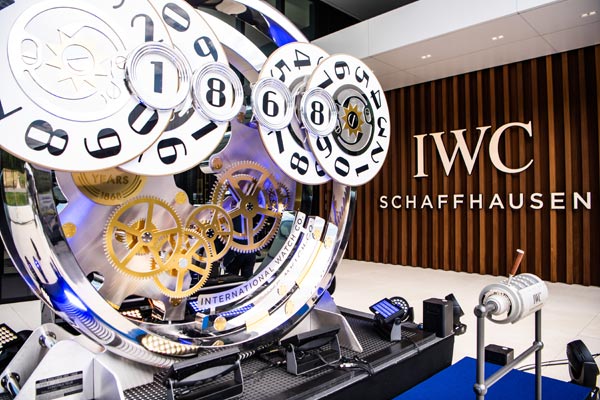
The architectural presence of the new manufacture, in addition to being a status symbol for IWC, also transports anyone stepping inside the impressive 9-metre-high entrance hall into a dimension where the words “engineering” and “technology” are given concrete form. Not only is the equipment all cutting-edge, but the way it has been installed inside the space allows for a flow of production and communication between the different divisions and teams, which are all optimally housed on a single floor (except for case production, which is in the basement). And that provides some explanation for the building’s dimensions: 139 metres long by 62 metres wide. IWC’s COO Andreas Voll is visibly delighted: “For the first time in our history, we are bringing together the production of movement components, manufacture movements and cases in one place. This important step has enabled us in particular to configure our production processes precisely as is best for ensuring that they run optimally and produce perfect quality. So, for example, the entire process of creating value, from the raw material to the individual movement component and on to the finished manufacture movement, progresses in a logical order on a single storey. The close proximity of the offices and the production facilities also facilitates communication and allows the different departments to coordinate more quickly.” On the back of the grey smocks worn by all production staff, four words are written in white letters: “Engineering time since 1868”.
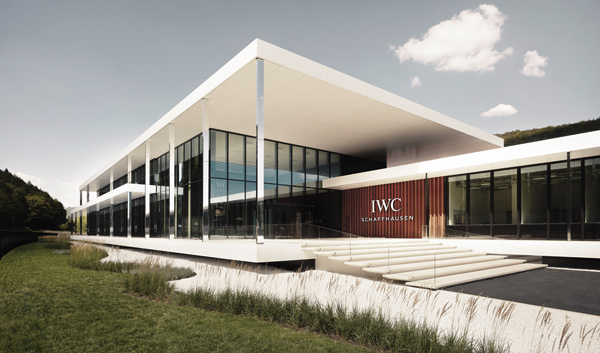
This brand-new industrial complex houses the more than 1,500 different components that are used in watch production, some of them smaller than a hair. Some rooms operate in a controlled atmosphere, as do all the operations facilities. Data analysis provides an immediate understanding of where any errors occur, and allows them to be corrected, continually optimising the production process and thus controlling costs. This ultimately benefits the end clients, who know they are buying their IWC watch at the fairest price. As Andreas Voll also notes: “Organising the assembly of our various different calibre families in dedicated production lines guarantees a maximum level of quality.” For him, the this multi-stage assembly process is the main advantage.
Treasure box
Germanic rigour is also apparent in the production stages that require the most human intervention, including the polishing of gold cases. Depending on the case type, between 26 and 50 different positions are necessary for polishing, or pre-polishing, each piece. Each batch of 60 cases takes a technician one week to complete. In the space of one year, the gold dust recovery system can recycle two kilos of precious metal! IWC’s expertise in machining cases dates back to the 1980s, and translates into a wide choice of materials for its clientele: steel, bronze, red and white gold, platinum, titanium and, more recently, Ceratanium, which has been patented by IWC. “This groundbreaking new case material is as robust and as light as titanium and as hard and as scratch-resistant as ceramic materials,” explains Andreas Voll. An entire floor is dedicated to cases. While comfort on the wrist is paramount, even the engravings on the case back – whether to be admired in private or shown off by the owner – require specific skills in etching, laser or mechanical engraving. The same applies to other machining techniques including diamond turning, which specialists employ to shave slivers of red gold or bronze from the Portugieser chronographs, for example.
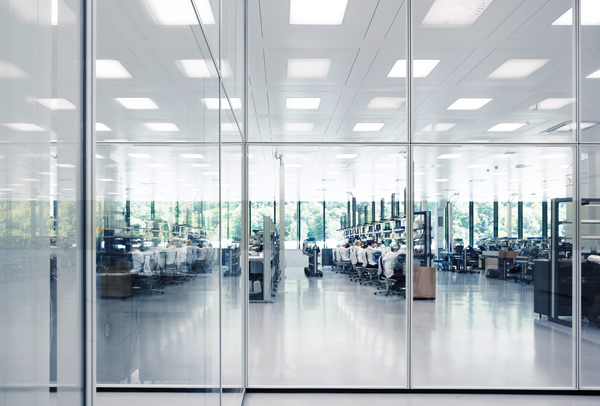
Visits are part of the concept
In his opening address, Christoph Grainger Herr mentioned the potential for welcoming 10,000 visitors per year. It’s a fascinating possibility. Indeed, the idea of creating a customer experience through a factory visit was incorporated into the architectural vision from the outset. A circuit has been planned over two floors, marked out on the floor in anthracite grey. Visitors are asked to keep strictly to the path, for reasons of safety and contamination. Guides have been trained to accompany tour groups, with commentary available in nine languages. Information panels provide further explanations at different stops on the tour, showing movement blanks at various stages of the manufacturing process. A glass alcove with two workshops has been created in the heart of the watchmaking department, to avoid disturbing the watchmakers while they work. Two watchmakers are available to explain the rudiments of their work to visitors. Visitors can apply to their IWC retailer to arrange their guided tour.
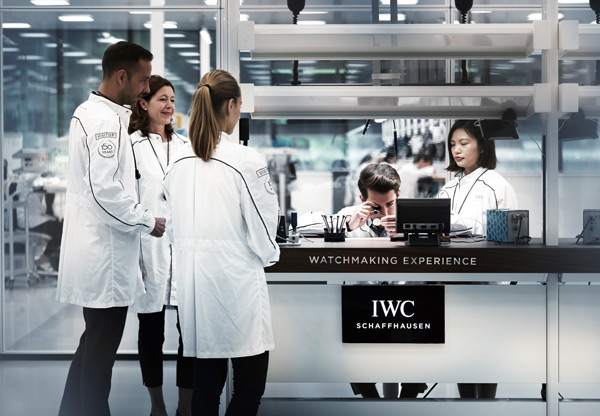
So what will happen to IWC’s historic premises in the centre of Schaffhausen? Out of the four buildings previously occupied by IWC, only the Neuhausen site has been sold. More than 500 employees remain in the other buildings, including all the headquarters staff, the after-sales department and the complication workshops.
